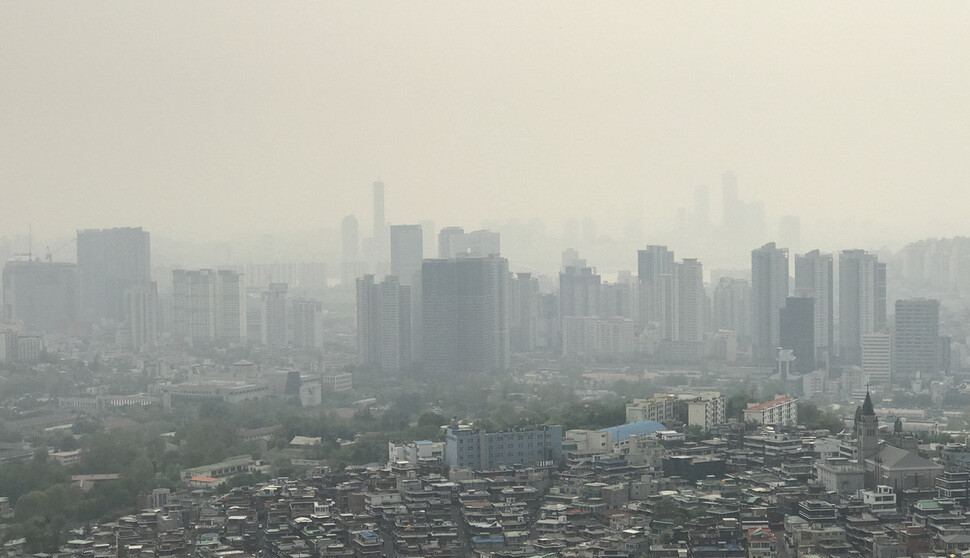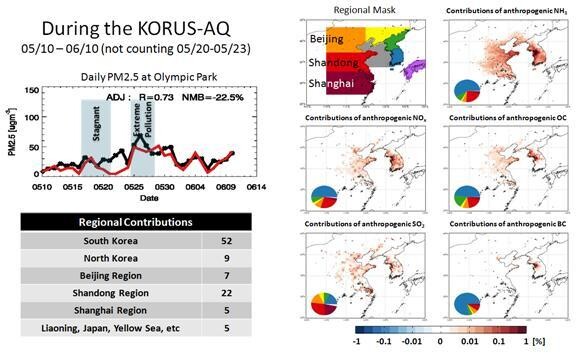hankyoreh
Links to other country sites 다른 나라 사이트 링크
NASA and NIER study finds that 48% of particulate matter comes from outside S. Korea

NASA and South Korea’s National Institute of Environmental Research (NIER) released the results of a joint study finding that 48% of the particulate matter (PM2.5) measured in Olympic Park, Seoul, in May and June 2016 came from outside the country. The organizations also found that the volatile organic compounds (VOCs) detected in the air around the Daesan Chemical Industrial Park in Seosan, South Chungcheong Province, are at a level that raises concerns about residents’ health.
The foreign contribution rate to ultrafine particulate matter found in the joint study may be of limited generalizability because the study was conducted in one area at one particular time of the year when the concentration of ultrafine particulate matter is not very high. But it does boost the credibility of Ministry of Environment findings, since it falls within the scope of the foreign influx rate (30-50% throughout the year, and 60-80% at times of high concentration) of ultrafine particulate matter that the Ministry has previously released.
The particulate matter was measured at Olympic Park in Seoul between May 2 and June 12, 2016, which was the period of the Korea-US Air Quality Study (KORUS-AQ). When the domestic and foreign contribution rate of this particulate matter was divided into eight sectors (four regions in China, North Korea, the West [Yellow] Sea, Japan, and South Korea), analysts found that the domestic contribution rate was 52%.

The Ministry of Environment released these analytical results during a briefing about the preliminary report from the KORUS-AQ that was held at the Press Center in Seoul on July 19. KORUS-AQ was a joint research product carried out by NIER and NASA with the participation of 80 organizations and over 580 scientists in South Korea and overseas with the goal of identifying the characteristics of air pollution in South Korea.
An analysis of the contribution rate of the ultrafine particulate matter measured at Olympic Park in Seoul between May 2 and June 12, 2016 (the period of the KORUS-AQ), found a domestic contribution rate of 52% and a foreign contribution rate of 48%. The foreign contribution rate was subdivided into 22% for China‘s Shandong Province, 9% for North Korea, 7% for Beijing, 5% for Shanghai, and a combined 5% for the three regions of China’s Liaoning Province, Japan and the West Sea. The analysis of the contribution rate was carried out using the new technique of inverse modeling rather than the brute force approach that NIER uses. The technique of inverse modelling traces changes in concentration back to the source based on a wide range of measurement data, including aeronautical observations. This makes it more accurate than the brute force approach, which wholly relies on highly uncertain statistics about emissions. The analysis of the contribution rate used data collected by NASA’s DC-8 Airborne Science Laboratory, which passed through the air above Olympic Park 52 times over the course of 20 days.
“One limitation of this joint study is that it took place at a time of the year when particulate matter from overseas does not have a major impact. But since it confirmed a large number of instances when even the domestic impact alone was raising the concentration of ultrafine particulate matter above the level recommended by the World Health Organization, it showed that a lot of effort needs to be made domestically in order to reduce the concentration of particulate matter,” said Kim Jeong-su, director of NIER’s atmospheric and environmental research department.
Analysts at NIER and NASA also found that the emissions of VOCs around Seosan, North Chungcheong Province, collected by the government‘s Clean Air Policy Support System (CAPSS) only represented one-third of the actual emissions estimated through aeronautical observations. In the preliminary report containing the findings of the joint study that was released on July 19, the two organizations voiced concerns about the possibility of long-term health consequences for workers at the Daesan Chemical Industrial Park in Seosan, as well as residents of the area and frequent visitors.
By Kim Jeong-su, senior staff writer
Please direct questions or comments to [english@hani.co.kr]

Editorial・opinion
![[Column] Season 2 of special prosecutor probe may be coming to Korea soon [Column] Season 2 of special prosecutor probe may be coming to Korea soon](https://flexible.img.hani.co.kr/flexible/normal/500/300/imgdb/original/2024/0426/3317141030699447.jpg) [Column] Season 2 of special prosecutor probe may be coming to Korea soon
[Column] Season 2 of special prosecutor probe may be coming to Korea soon![[Column] Park Geun-hye déjà vu in Yoon Suk-yeol [Column] Park Geun-hye déjà vu in Yoon Suk-yeol](https://flexible.img.hani.co.kr/flexible/normal/500/300/imgdb/original/2024/0424/651713945113788.jpg) [Column] Park Geun-hye déjà vu in Yoon Suk-yeol
[Column] Park Geun-hye déjà vu in Yoon Suk-yeol- [Editorial] New weight of N. Korea’s nuclear threats makes dialogue all the more urgent
- [Guest essay] The real reason Korea’s new right wants to dub Rhee a founding father
- [Column] ‘Choson’: Is it time we start referring to N. Korea in its own terms?
- [Editorial] Japan’s rewriting of history with Korea has gone too far
- [Column] The president’s questionable capacity for dialogue
- [Column] Are chaebol firms just pizza pies for families to divvy up as they please?
- [Column] Has Korea, too, crossed the Rubicon on China?
- [Correspondent’s column] In Japan’s alliance with US, echoes of its past alliances with UK
Most viewed articles
- 1[Column] Season 2 of special prosecutor probe may be coming to Korea soon
- 2‘We must say no’: Seoul defense chief on Korean, USFK involvement in hypothetical Taiwan crisis
- 3Is N. Korea threatening to test nukes in response to possible new US-led sanctions body?
- 4Division commander ordered troops to enter raging flood waters before Marine died, survivor says
- 5Is Japan about to snatch control of Line messenger from Korea’s Naver?
- 6No good, very bad game for Korea puts it out of Olympics for first time since 1988
- 7[Editorial] Korea’s surprise Q1 growth requires objective assessment, not blind fanfare
- 8Korea’s 1.3% growth in Q1 signals ‘textbook’ return to growth, says government
- 9N. Korean delegation’s trip to Iran shows how Pyongyang is leveraging ties with Moscow
- 10Amnesty notes ‘erosion’ of freedom of expression in Korea in annual human rights report